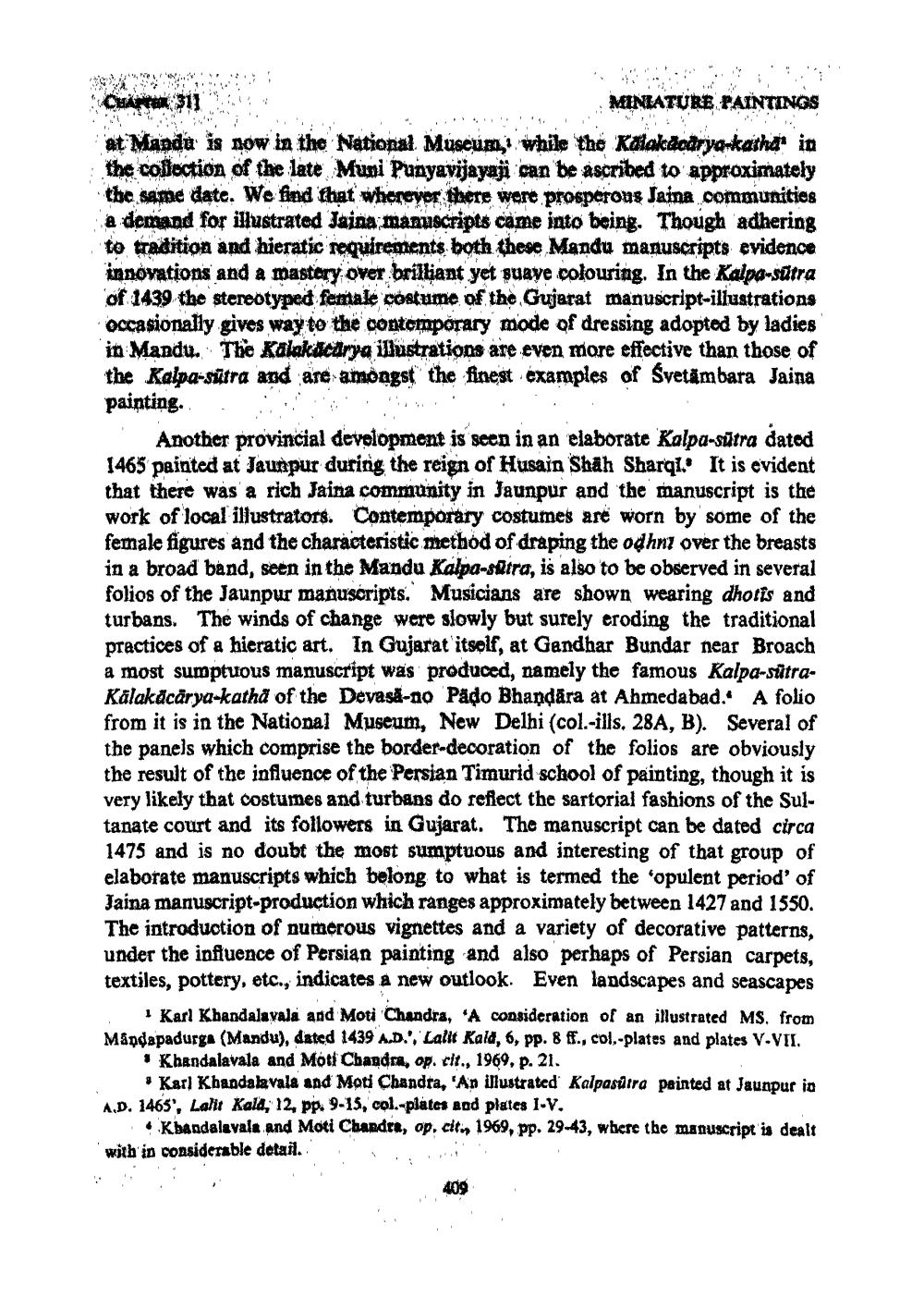________________
N
;
OHARRAK: 311
MINIATURE PAINTINGS at Manda is now in the National Museum, while the Kalakhodrya-katha in the collection of the late Muni Punyavijayaji can be ascribed to approximately the same date. We find that wherever there were prosperous Jaina communities a demand for illustrated Jaina manuscripts came into being. Though adhering to tradition and hieratic requirements both these Mandu manuscripts evidence innovations and a mastery over brilliant yet suave colouring. In the Kalpa-sūtra of 1439 the stereotyped female costume of the Gujarat manuscript-illustrations occasionally gives way to the contemporary mode of dressing adopted by ladies in Mandu. The Kalakdcarya illustrations are even more effective than those of the Kalpa-sütra and are amongst the finest examples of Svetämbara Jaina painting. .
Another provincial development is seen in an elaborate Kalpa-sūtra datod 1465 painted at Jaunpur during the reign of Husain Shah Sharqi. It is evident that there was a rich Jaina community in Jaunpur and the manuscript is the work of local illustrators. Contemporary costumes are worn by some of the female figures and the characteristic method of draping the odhni over the breasts in a broad band, seen in the Mandu Kalpa-sutra, is also to be observed in several folios of the Jaunpur manuscripts. Musicians are shown wearing dhotis and turbans. The winds of change were slowly but surely eroding the traditional practices of a hieratic art. In Gujarat itself, at Gandhar Bundar near Broach a most sumptuous manuscript was produced, namely the famous Kalpa-sütraKälakācārya-katha of the Devasd-no Pädo Bhandara at Ahmedabad. A folio from it is in the National Museum, New Delhi (col.-ills. 28A, B). Several of the panels which comprise the border-decoration of the folios are obviously the result of the influence of the Persian Timurid school of painting, though it is very likely that costumes and turbans do reflect the sartorial fashions of the Sultanate court and its followers in Gujarat. The manuscript can be dated circa 1475 and is no doubt the most sumptuous and interesting of that group of elaborate manuscripts which belong to what is termed the 'opulent period of Jaina manuscript-production which ranges approximately between 1427 and 1550. The introduction of numerous vignettes and a variety of decorative patterns, under the influence of Persian painting and also perhaps of Persian carpets, textiles, pottery, etc., indicates a new outlook. Even landscapes and seascapes
1 Karl Khandalavala and Moti Chandra, 'A consideration of an illustrated Ms. from Måndapadurga (Mandu), dated 1439 A.D.', Lalit Kald, 6, pp. 8 ff.,col.-plates and plates V.VII.
• Khandalavala and Moti Chandra, op. cit., 1969, p. 21.
• Karl Khandalavala and Moti Chandra, 'An illustrated Kalpasúira painted at Jaunpur is A.D. 1465', Lalit Kala, 12, pp. 9-15, col.-plates and plates 1.V.
Kbandalavala and Moti Chandra, op. cit., 1969, pp. 29-43, where the manuscript is dealt with in considerable detail.




